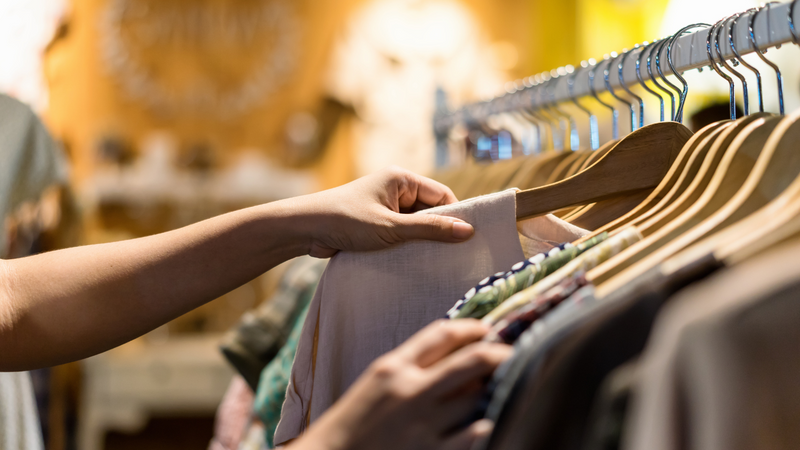The practice of thrifting, commonly referred to as secondhand shopping, has grown in popularity recently. The technique entails buying secondhand goods from garage sales, thrift shops, and internet and social media markets, including apparel, furniture, and home décor. Shopping at thrift stores offers many advantages for the environment and the community in addition to being enjoyable and reasonably priced.

Beginning in the early 1800s when charity groups started selling donated goods to make money, thrift stores have a lengthy history. For instance, the Salvation Army established its first thrift shop in London in 1865. The Great Depression of the 1930s forced individuals to discover methods to conserve money, and this is when the idea of thrift shopping first became popular. Thrift shopping evolved into a patriotic activity during World War II as individuals were encouraged to reuse and give products to save money for the war effort.
Thrift store shopping nowadays not only allows you to save money but also lessens waste and benefits the environment. We may lower the demand for new things and the resources required to generate them by buying secondhand goods.
For instance, manufacturing new clothing uses a lot of water, energy, and chemicals. One cotton shirt requires 2,700 litres of water to create, which is enough water for one person to drink for 2.5 years, according to the World Wildlife Fund. New furniture production also uses a lot of resources and can hasten the destruction of forests.
By giving new life to objects that would otherwise end up in landfills, thrift shopping also contributes to the reduction of waste. The Environmental Protection Agency estimates that each American discards 10 pounds of clothing yearly, amounting to around 14.3 million tonnes of textile trash. We may contribute to reducing this waste and extending the life of these products by giving and buying worn clothing.

Thrifting has economic and social advantages in addition to environmental ones. Thrift shops frequently donate to charitable organisations, and they also give local residents jobs and training. By making our purchases at thrift stores, we can help these organisations and the creation of jobs. For those who might not be able to afford new stuff, thrift stores also provide reasonably priced clothing and home items.
Many factors have contributed to the rise in popularity of thrift stores recently. The growth of ethical and sustainable fashion is one of the causes. Many people are looking for alternatives to fast fashion as they become more aware of how the fashion industry affects the environment and human rights. An economical and ecological substitute for buying new clothing from fast fashion firms is thrift shopping. Their attractiveness is increased by the fact that many thrift shops also sell vintage and one-of-a-kind things that are unavailable in conventional retail establishments.
Moreover, social media has contributed to the growth of thrift stores. The term "thrifting" has gained popularity because of websites like Instagram, which have also sparked a community of people who post their thrift store purchases and styling advice. Millions of posts under hashtags like #thrifted and #secondhandfashion demonstrate how common thrift shopping is among young people.
Here are some famous thrift accounts you can check out from India
- Bombay Closet Cleanse
- Copper Boom
- Curated Findings
- LuLu Thrift
- Lus Thrift
- Luu Liu
- Mumbai Thrifts
Note: It's always a good idea to do your own research and make sure the accounts you follow are trustworthy and have a good reputation before making any purchases.

The appeal of simplicity and decluttering is another factor in thrift store success. Many people are adopting a minimalist lifestyle and making an effort to own fewer items. By giving away and selling items they no longer need and replacing them with used ones, thrift shopping offers a means for people to simplify their lives and clear their homes.
There has been a boom of second-hand items marketplaces, which have made thrift shopping easier to reach in recent years. These online marketplaces make it simple to acquire and sell used products and have contributed to the emergence of a more widely accepted secondhand market.
Thrifting is a pleasant and cost-effective kind of shopping that has a lot of advantages for the community and the environment. Due to its positive effects on the environment, the economy, and society as well as the emergence of ethical and sustainable design, social media, and the minimalism and decluttering trends, thrift shopping has grown in popularity in recent years.
There are a few pointers that can help you get the most out of your thrift store experience
- Keep an open mind - In order to find what you're looking for, it's first vital to have an open mind and be willing to sift through racks and shelves. Having a broad notion of what you're searching for, whether it's a specific item or a general style or colour, is essential because thrift stores may be overwhelming. Also, it's crucial to inspect the product’s condition, looking for any stains, holes, or evidence of wear and tear.
- Keep at it - It's also a good idea to be persistent and patient. Regular new donations are made to thrift stores, so it's worthwhile to return frequently to see what's new. If you're looking for anything in particular, it can take you a few trips to discover it, but part of the fun of thrift shopping is the thrill of the chase.
- The pricing - Thrift stores have a wide range of prices. Some may utilise a sliding scale based on the item's age or condition while some may have fixed prices for products. While thrift shopping can be a terrific way to save money, it's vital to support the charities and organisations that manage these stores as well. If you discover a terrific deal, think about giving the charity a donation or offering your services as a volunteer.
- Environment-friendly products - Not only is shopping at thrift stores enjoyable and inexpensive, but it also has a positive effect on the neighbourhood and the environment. By buying used goods, we can prolong the lives of items that would otherwise end up in landfills while lowering the demand for new goods and the resources utilised to generate them.
By aiding philanthropic endeavours, supplying employment opportunities, and offering education and training to local residents, thrift stores also benefit the economy and society. It's understandable why thrift shopping has grown in popularity in recent years given all of its advantages. Hence, the next time you want to go shopping, think about going to a thrift store in your neighbourhood or online!
Brands all around the world try to be more sustainable today and more and more insights are reinforcing why sustainable luxury is the need of the hour. Here are 10 brands that are redefining what it means to be sustainable.
Disclaimer: The details mentioned throughout this blog are sourced from publicly accessible platforms. At Zeezest, we intend to share factual and verified information. Should there be any inconsistencies or variances in the information provided, please understand that these are entirely unintentional and not meant to mislead.


_1681275423220_thumb_1200.png?w=3840&q=75)

